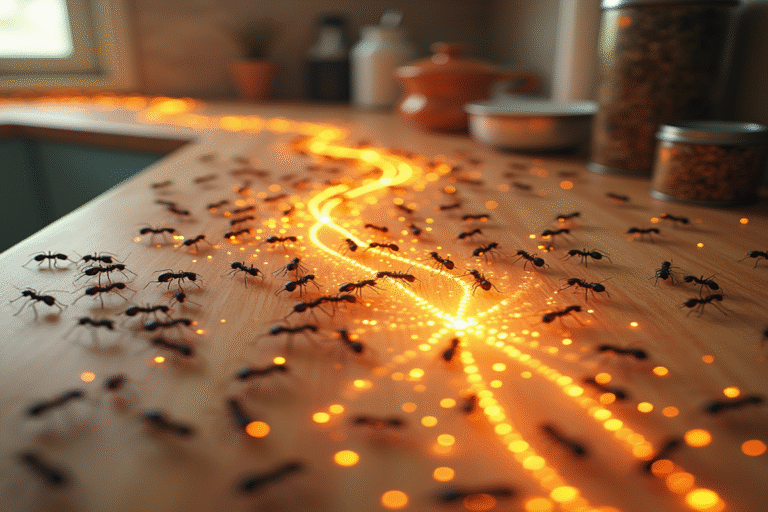Have you ever noticed a parade of ants marching in a perfect line across your kitchen counter? What might look like a simple trail is actually part of an incredibly sophisticated navigation system that rivals our most advanced traffic networks. Ants, despite having brains smaller than a pinhead, create elaborate highway systems that efficiently connect their colonies to food sources and other important locations.
The Invisible Infrastructure: Pheromone Communication
At the heart of ants’ impressive navigation abilities is a chemical communication system millions of years in the making. Ants produce special chemicals called pheromones from various glands in their bodies. These chemical compounds serve as the foundation for their entire social structure, including transportation networks.
When an ant discovers a food source, it deposits a pheromone trail on its return journey to the nest. This invisible scent path becomes a communication tool that other ants can detect with their highly sensitive antennae. The more ants that follow and reinforce this trail, the stronger the scent becomes, creating a positive feedback loop that establishes well-traveled routes.
From Simple Trails to Complex Highways
What’s truly fascinating is how these individual actions scale up to create complex transportation networks. As multiple ants forage and establish trails, the colony inadvertently creates a sophisticated system of interconnected paths. The most frequently used routes receive the most pheromone reinforcement, eventually evolving into the equivalent of ant superhighways.
These main routes can handle tremendous ant traffic—sometimes thousands of ants per hour—moving in both directions with little congestion. Researchers have found that some species even create lane discipline, with ants returning to the nest keeping to one side while outbound ants use the other, preventing the insect equivalent of traffic jams.
Nature’s Efficiency Engineers
Ant colonies solve complex optimization problems without any central planning. When multiple paths to a food source exist, ants initially explore all options. However, the shorter routes can be traversed more quickly, allowing ants to make more trips in less time, which means more pheromone is deposited on the shortest path. This creates a natural optimization system that identifies the most efficient routes.
In a famous experiment reflecting the “Traveling Salesman Problem”—a notoriously difficult mathematical challenge—researchers found that Argentine ants could find near-optimal solutions for connecting multiple points with the shortest possible route, a problem that would require significant computing power for humans to solve.
Traffic Management Without Engineers
Even more impressively, ants have evolved mechanisms to prevent traffic jams. When congestion occurs on a trail, some species adjust their behavior in several ways:
- Increasing the width of highways when traffic volume grows
- Creating bypass trails around bottlenecks
- Adjusting their speed and spacing based on traffic conditions
- Some species even use their bodies to fill potholes and smooth out rough surfaces on frequently used trails
The army ants of Central and South America take this to another level, creating “living bridges” with their bodies to span gaps in the trail. These bridges dynamically adjust their size based on traffic flow, with ants joining or leaving the structure to optimize the path and workforce.
A Chemical GPS System with Built-in Updates
The pheromone system constantly provides ants with updated information about their environment. Since these chemical markers naturally evaporate over time, abandoned or less productive food sources see their trails fade away, while promising areas maintain strong scent highways. This creates a dynamic map that reflects current conditions rather than outdated paths.
Some ant species even use multiple types of pheromones with different meanings, creating a chemical language that can communicate food quality, danger warnings, or colony needs. This sophisticated chemical signaling network helps direct the collective workforce where it’s most needed.
The Chemistry Behind the Magic
The pheromones ants use for trail-marking are fascinating molecules. Different species produce different chemical compounds, but many use carboxylic acids and alcohols with chains of carbon atoms. For instance, the common Argentine ant (Linepithema humile) uses a molecule called (Z)-9-hexadecenal for its main trail pheromone.
What’s remarkable is the sensitivity of ant detection systems—they can detect just a few molecules of these compounds, equivalent to finding a grain of salt in an Olympic-sized swimming pool. Some ants can even determine the age of a pheromone trail based on subtle changes in the chemical composition as it breaks down.
Inspiring Human Innovation
The efficiency of ant transportation networks has inspired numerous human innovations. Computer scientists have developed “ant colony optimization” algorithms that mimic this decentralized problem-solving approach to tackle everything from telecommunications routing to supply chain management.
These algorithms have helped optimize delivery routes, network traffic, and even public transportation systems. By studying how simple rules followed by individual ants create efficient systems at scale, researchers continue to find applications in artificial intelligence, robotics, and urban planning.
Next time you spot an ant trail, take a moment to appreciate the invisible chemical architecture guiding these tiny creatures. What appears to be a simple line of insects is actually a manifestation of one of nature’s most sophisticated transportation systems—a decentralized network that solves complex problems through collective intelligence and chemical communication.





